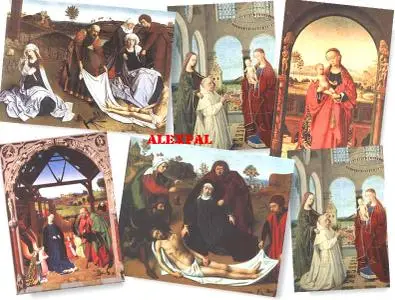Art by Petrus Christus
19 JPG | up to 800x1300 | 3 Mb
19 JPG | up to 800x1300 | 3 Mb
Petrus Christus (c. 1410/1420 – 1475/1476) was a Netherlandish painter active in Bruges from 1444.
Christus was born in Baarle-Hertog, near Antwerp, Belgium. Long considered a student of and successor to Jan van Eyck, his paintings have sometimes been confused with those of Van Eyck. At the death of Van Eyck in 1441, it was reasoned, Christus took over his master's workshop. In fact, Christus purchased his Bruges citizenship in 1444, three years after Van Eyck's death.
Had he been an active pupil in Van Eyck\'s Bruges workshop in 1441, he would have received his citizenship automatically after the customary period of one year and one day. In other words, Christus may be Van Eyck\'s successor in the Bruges school, but he was by no means his pupil. In fact, recent research reveals that Christus, long seen only in his great predecessor\'s light, was an independent painter whose work shows just as much influence from, among others, Dirk Bouts, Robert Campin and Rogier van der Weyden.
It is still unknown whether Christus visited Italy, and brought the style and technical accomplishments of the greatest Northern European painters directly to Antonello da Messina and other Italian artists, or whether his paintings were purchased by Italians. A document testifying to the presence of a \"Piero da Bruggia\" (Petrus from Bruges?) in Milan may suggest that he visited that city at the same time as Antonello, and the two artists may even have met. This might account for the remarkable similarities between the Portrait of a Man attributed to Christus in the Los Angeles County Museum of Art and many of Antonello\'s portraits, including the supposed self-portrait in the National Gallery in London. It would also be a convenient means of explaining how Italian painters learned about oil painting and how Northern painters learned about linear perspective. Antonello, along with Giovanni Bellini, was one of the first Italian painters to use oil paint like his Netherlandish contemporaries. And Christus\' Virgin and Child Enthroned with Saints Francis and Jerome in Frankfurt, seemingly dated 1457 (the third digit is illegible), is the first known Northern picture to demonstrate accurate linear perspective. The composition of a Lamentation now at the Metropolitan Museum of Art so closely inspired a marble relief by Antonello Gagini in the cathedral at Palermo that it has been suggested that the picture may have been painted for an Italian client.
A late work, the reserved Portrait of a Young Girl belongs among the masterworks of Flemish painting, marking a new development in Netherlandish portraiture. It no longer shows the sitter in front of a neutral background, but in a concrete space defined by the wall panels. Christus had already perfected this format in his two portraits of 1446. The unknown woman, whose exquisite clothing suggests that she might come from France, radiates an aura of discretion and of nobility, while appearing slightly unreal in the elegant stylization of her form.
Christus died in Bruges in 1475 or 1476. Hans Memling succeeded him as the next great painter in Bruges.
Download from Easy-Share
or
Download from Depositfiles
or
Download from Rapidshare
No MIRRORs below!
: Welcome!
or
Download from Depositfiles
or
Download from Rapidshare
No MIRRORs below!



